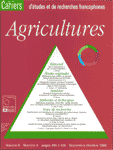Amélioration de la technique de production des semenceaux d'igname ("Dioscorea rotundata" Poir.)
Résumé
White yam (Dioscorea rotundata Poir.) is an annual crop grown almost exclusively for its tubers, which are a good source of carbohydrates. It is mainly cropped in the "yam zone", an area extending from the Cameroonian mountains to central Cote d'Ivoire. Here food yams play a vital role in nutrition, traditional culture, rituals, religion, and local commerce. The major constraint to yam production is the cost of planting material, which represents 38-45% of total production costs. This study was undertaken to investigate (i) different sprouting media which could replace sawdust for germination of yam minisetts; (ii) the effect of different types of mulch, plant staking, and population densities on seed yam yields, using 20 to 30g minisetts as planting material. Sprouting media, such as topsoil, sand, coffee husks, and gravel can replace sawdust for germination of yam minisetts (Table 1). The very porous latter three media must be mulched in order to improve water retention; watering frequency should also be increased to keep these media permanently wet, thus improving sprouting conditions. Healing minisett wounds for 1, 2, or 3 days increased rotting (Table 2). Polyethylene mulch, with the white side up, increased seed yam yields (23.75t/ha). This practice, combined with plant staking, increased seed yam yields even further (30.50t/ha). In the absence of black-and-white polyethylene mulch, staking yam plants increased seed yam yields under standard farm conditions (22.75t/ha). When yam plants were neither mulched nor staked, yield dropped drastically (13.73t/ha) because of tuber weight reduction (Table 3). Using plastic mulch and/or staking yam plants provided the best conditions for the production of abundant high quality planting material. The performance of minisetts under plastic mulch (white side up) was better than without mulch (Table 4). At each plant density, the mean tuber size was over 50% larger under plastic mulch than in the no-mulch treatment; the proportion of marketable tubers (more than 200g) was also greater with mulch. Tuber size decreased with increasing plant densities. For cv Malende (lowland cultivar), the mean tuber weight ranged from 940.54g at 20,000 plants/ha to 311.47g at 100,000 plants/ha. With cv Bonakanda (medium elevation cultivar), mean tuber weight was lowest in the no-mulch treatment (ranging from 533.74g at 20 000 plants/ha to 182.14g at 100,000 plants/ha); the yield was also the lowest (16.32t/ha). To produce good quality seed yams, cultivars adapted to the ecological conditions of the production zone should be chosen; yam plants should also be mulch and/or staked, and high density plant populations (80,000 to 100,000 plants/ha) should be adopted to obtain high yields (28.90 to 30.40 t/ha, respectively).Téléchargements
Publié
1999-09-01
Comment citer
Segnou, M. (1999). Amélioration de la technique de production des semenceaux d’igname ("Dioscorea rotundata" Poir.). Cahiers Agricultures, 8(5), 405–408 (1). Consulté à l’adresse https://revues.cirad.fr/index.php/cahiers-agricultures/article/view/30198
Numéro
Rubrique
Articles

